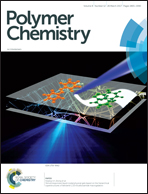Hydrogen bonding in radical solution copolymerization kinetics of acrylates and methacrylates: a comparison of hydroxy- and methoxy-functionality†
Abstract
The pulsed-laser polymerization technique in combination with size exclusion chromatography and nuclear magnetic resonance is used to study the influences of solvent choice and monomer structure on the copolymerization propagation kinetics of 2-hydroxyethyl acrylate (HEA) and 2-methoxyethyl acrylate (MEA). The similarity in the monomer structures provides a means to isolate the influence of H-bonding, which increases the incorporation of HEA into copolymer relative to that of butyl acrylate (BA) dependent on solvent choice. The copolymer-averaged propagation rate coefficient, kcopp, for HEA/BA is also increased over that of BA homopropagation, and is highly influenced by solvent choice. In contrast, MEA copolymerized with butyl acrylate (BA) and butyl methacrylate (BMA) in multiple solvents revealed classic behaviour, with no solvent effects exerted on kcopp or reactivity ratios other than the increase of kcopp in n-butanol (BuOH). The value of kMEAp was determined to be 35 000 L mol−1 s−1 at 50 °C, 30% higher than the value for BA. In a simplified modelling approach, penultimate-unit parameters for BMA/BA were used to represent the evolution of kcopp for BMA/MEA in bulk.



 Please wait while we load your content...
Please wait while we load your content...